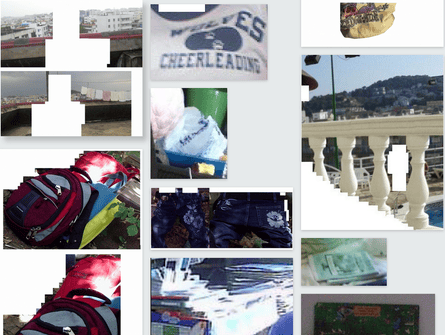It looks like a normal bathroom tile. But when amateur internet sleuths managed to locate it, they found the missing piece in an international child abuse investigation.
This was one of the clues that led to the arrest of a suspect and the identification of nine child abuse victims.
There’s nothing new about the police asking for tips – think missing person posters or episodes of Crimewatch. But the Trace an Object crowdsourcing effort launched by Europol in 2017 asks individuals and collectives to find clues for unsolved child abuse investigations by identifying parts of digital images.
It could be a slice of cheese that someone recognises as Belgian, a crumpled shopping bag or a brightly coloured child’s duvet cover: it just needs a moment of recognition – human or digital – to fill in the gaps that lead police to a suspect or a victim.

The pictures Europol posts online are drawn from a grim stash of 30m images of child sexual exploitation, which are often circulating on the dark web. Steven Wilson, the head of the agency’s European cybercrime centre, said that some are linked to crimes happening now and others document abuse from decades ago.
Wilson said: “In the cases we deal with here, we have done as much as we can with law enforcement and this is a final throw of the dice.
“In most cases, we are trying to identify a location and the eyes of the world can look at something that you can’t possibly replicate, even by online analysis. If we can narrow it down to one country or an area, that’s a massive starting point.”
Quick GuideWhat is the Upside?
Show
Ever wondered why you feel so gloomy about the world - even at a time when humanity has never been this healthy and prosperous? Could it be because news is almost always grim, focusing on confrontation, disaster, antagonism and blame?
This series is an antidote, an attempt to show that there is plenty of hope, as our journalists scour the planet looking for pioneers, trailblazers, best practice, unsung heroes, ideas that work, ideas that might and innovations whose time might have come.
Readers can recommend other projects, people and progress that we should report on by contacting us at theupside@theguardian.com
The response has stunned investigators: 283 posted images have led to 22,000 emails. Investigative groups such as Bellingcat have set up a Check platform to organise the workflow, and a Reddit community has also got stuck in.
“Bellingcat has done a huge amount of investigative work,” added Wilson. “We reached out to them and they have passed on some of their technical expertise to do particular things … We can’t stay doing the things we have been doing for many years because we’ll only get the same results – we have to try new ideas.”
This pilot has been adopted as a longer-term initiative at Europol, which passes confirmed tips to local police forces to help get victims to safety and start the prosecution process.
For one Europol officer, who has spent months studying unedited images of child abuse to build up leads, it is a eureka moment when a crowdsourced tip leads to an arrest. “It feels awesome,” said the officer, who did not want to be identified. “It’s an extremely motivating element for doing the job.”
The officer works in an imposing building in The Hague, where the revolving security door is labelled a “tourniquet” and there is compulsory counselling to help process the effects of such work.
Elsewhere in the Netherlands lives Bo, a moderator of the amateur investigative group Serendip. Bo, who would only be interviewed by email and would not give out any personal details, guides a team of 15 people who recently helped identify a rooftop in China for Europol.
“We are pretty sure that we have found 40 images,” Bo wrote. “Europol doesn’t really ever reply. Sometimes it puts a ‘like’ on Twitter. That’s a shame. We mostly find the things they ask for quickly but we often don’t know what happens next.”
Eliot Higgins, the founder of Bellingcat, explains that people such as Bo use “weirdly basic” open-source techniques to reverse-search images on publicly shared archives. They look for clues related to lighting conditions or a season to identify a location.
Higgins said: “Sometimes it’s just a matter of recognising shopping bag brands. Some of it’s more obscure. There was a photo taken of a hotel, which showed a whole room with two figures blurred out. Very rapidly someone said that they had been there, and it was in Mauritius. When we went to the website of the hotel, they had a photo that was the exact same angle, of a room that was almost identical. That just relies on someone seeing the tweet who knows what it is.”
People may sometimes identify more than a simple item, Higgins added. “Sometimes we can find the images of the victims, clearly from the same photo set. There’s at least one case where it was possible to identify a likely suspect as well. That has big issues if that gets out in public and people decide to start tracking these people down themselves.”
This also could alert a suspect to destroy potential evidence, said Bo.
Getting amateurs involved in police work does have risks, according to Frederik Zuiderveen Borgesius, a law professor at Radboud University Nijmegen and a fellow at the University of Amsterdam’s institute of information law.
Borgesius said: “Criminal law contains rules that limit police power, to protect individuals suspected of some kind of crime against the state. We can generally assume the police force is trained on those rules: even though you are investigating crime, there are limits to what you can do. I’m afraid crowds don’t always know those rules and might become overly enthusiastic in their own online echo chamber.
“In an extreme case, you could think there’s a risk of a lynch mob.”
These are all hazards Europol takes seriously. “You have got to balance that risk with the huge potential,” said Wilson.
“For the nine victims identified so far, this potentially has made a significant difference to their lives. On many occasions, people perpetrating this abuse are repeat offenders and if you can stop them, for me the most important thing is what future damage is prevented.”
This article is part of a series on possible solutions to some of the world’s most stubborn problems. What else should we cover? Email us at theupside@theguardian.com
